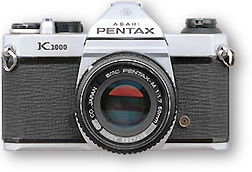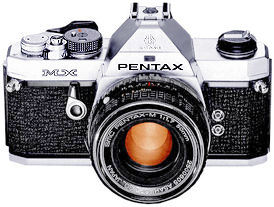To begin with, Pentax is a trade name
of Asahi Optical Co., Ltd. Founded in 1919 under the name of Asahi Optical Joint
Stock Company of Tokyo, Japan. But the company, Asahi Optical Co., Ltd. was named
in 1938. It is one of the oldest optical company in Japan. It also produced the Japan's
first SLR camera in 1954, the Asahiflex, which utilized an instant return mirror
system.
Followed by Asahi Pentax in 1957, the first camera that used the "Pentax"
trade name. In 1964/65, Asahi Optical released the famous Spotmatic line of cameras
which lasted until 1975 with the last model, SP-F (original Spotmatic, the SP, SP1000,
SP500, SL, Spotmatic F, Electro-Spotmatic, ES, ESII). Then, in 1975, Asahi Optical
introduced their bayonet mount - the K mount (The K mount was acted as a replacement
for the popular Pentax screw mount and it even remains as many third party cameras
standard mount). The K series was the first Pentax bayonet mount cameras (Models
like KX, KM, K2, K1000) and a year later, in 1976, Pentax introduced the M series
(Some models like MG, MV, MX, ME, ME-F, ME Super). While the Pentax ME-F, widely
acclaimed as the world's first TTL autofocus SLR camera employing a TTL autofocus
sensor was launched in 1982 with a dedicated AF Zoom lens. Subsequently, in the eighties
where the market was flooded with a new breed of multi-modes SLR, A-Series cameras
like Super A, Program Plus, Super Program, P3, P5 were introduced to provide users
with a wider selection. In addition to SLRs and compact cameras, Pentax's medium
format cameras have been strong sellers. These cameras include the Pentax 67 first
released in 1969 and the Pentax 645 released in 1984.
 |
Thus, the brief history above outlined the important role Pentax has played in the development of photography Camera models like the Spotmatics, the evergreen mechanical K1000 (Introduced in 1978 had a few upgrades and is still selling very hot), aperture-priority ME-Super, multimode Super A Program are some of the most and well remembered Pentaxes. One of the few key hallmarks of Pentax made cameras are functional and compactness of bodies, without the compromise of ruggedness. |
Although Pentax has never seriously putting up a challenge in the professional market with the like of the Nikon or Canon prior to the sixties and early seventies. They did made a very courageous attempt in the MX in 1976. It was originally design and targeted to the market of the hard working pros with a all new fully mechanical bodies and a wide arrays of system accessories. But should I said, it was a little untimely with its debut. The Nikon's F2 and the original Canon F-1 introduced in the early '70 has seen the users opted for a more responsive semi auto based system cameras. (Both the Nikon and the Canon has respective accessories to convert the all mechanical bodies into a shutter priority camera). While the secondary market, best represented by the immensely successful Canon AE-1, 1976, the Minolta's XD-7 and the Canon A-1 in 1978 has made the fully mechanical MX less appealing to many serious users on the field. Somehow, the MX has a very strong shadow of the Olympus OM-1 in 1972 (Will be featured later in this site along with OM2), but the real killer blow to the MX was the OM-2 in 1975, featuring the world's first TTL OTF metering - it was an instant hit and remained as Olympus's flagship models stretching to the early eighties.
But this has nothing to do with the camera itself, as I said earlier, it has to do with the change in market trend & users' requirement. For MX to survive in the highly competitive market place in the mid seventies with only a mechanical appeal, it was hard - Personally, I have always rated the Pentax MX as one of the best mechanical cameras ever produced by a manufacturer.
 BOTH OM series cameras and the Pentax M series bodies are synonymous with compactness, great versatility and functionality - that has made the like of Nikons, Canons so bulky in comparison. |
The Pentax M series, however has laid a strong foundation for the Pentax LX, Pentax's first full scale system camera aimed directly at the professional market. Where Pentax believes - a good compromise between compact, ruggedness and functionality can strike a neutral balance and co-exist. Perhaps, the MX lesson has given Pentax designer some clues of how to prepare and combine all these factors and the best of features of other makes into a all new system camera, the Pentax LX. |
Pentax LX |
Canon New F-1: |
Nikon F3HP |
565g with standard FA-1 finder. |
795g body only; 1,030g with FD 50mm f/1.4 lens. |
approx. : 760g approx. Nikon F3HP (without lens) |